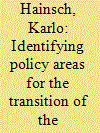|
|
|
Sort Order |
|
|
|
Items / Page
|
|
|
|
|
|
|
| Srl | Item |
| 1 |
ID:
116985


|
|
|
|
|
| Publication |
2012.
|
| Summary/Abstract |
This paper addresses the challenge of engaging civil society stakeholders in the development process of ambitious mitigation scenarios that are based on formal energy system modeling, allowing for the explicit attachment of normative considerations to technology-focused mitigation options. It presents the definition and model results for a set of mitigation scenarios for Germany that achieve 85% CO2 emission reduction in 2050 relative to 1990. During consecutive dialogues, civil society stakeholders from the transport and electricity sector framed the definition of boundary conditions for the energy-economy model REMIND-D and evaluated the scenarios with regard to plausibility and social acceptance implications. Even though the limited scope of this research impedes inferential conclusions on the German energy transition as a whole, it demonstrates that the technological solutions to the mitigation problem proposed by the model give rise to significant societal and political implications that deem at least as challenging as the mere engineering aspects of innovative technologies. These insights underline the importance of comprehending mitigation of energy-related CO2 emissions as a socio-technical transition embedded in a political context.
|
|
|
|
|
|
|
|
|
|
|
|
|
|
|
|
| 2 |
ID:
162942


|
|
|
|
|
| Summary/Abstract |
Ambitious decarbonization targets, technology-specific policies, and computational developments led to increases in the complexity and diversity of energy system models. The lack of transparency and standardization, however, renders the assessment of model suitability for specific policy questions difficult. Therefore, this paper systematically assesses the ability of energy system models to answer major energy policy questions. It examines the existing literature on model comparison schemes, then proposes a set of criteria to compare a sample of 40 models. Besides, a novel, model-oriented approach is developed in order to cluster energy policy questions. Finally, the model capabilities and the policy questions are brought together by quantifying the gap between models and policy questions. The results show that some models are very well able to answer a wide range of energy policy questions, whereas others are only suitable for a specific area of energy policy. The representation of the distribution grid, the endogenous adjustment of demand, and the technical flexibility of the energy system are among the features, where models generally lag behind. Our results provide policy-makers with guidance on crucial model features with respect to a selection of energy policy questions and suggest potential funding priorities for future energy system modeling.
|
|
|
|
|
|
|
|
|
|
|
|
|
|
|
|
| 3 |
ID:
191283


|
|
|
|
|
| Summary/Abstract |
Being the only energy sector where emissions are still at 1990 levels, the German transportation sector requires rapid decarbonization to achieve ambitious climate targets. Policy makers need to put the framework in place which enables and supports this transition. This work analyzes which policy areas should be targeted considering interactions with and implications for the entire energy system. The Global Energy System Model (GENeSYS-MOD) is used to compute 400 sensitivities which showcase the effectiveness of specific transport and energy system related policies. Shifting transportation demand to less energy and emission intensive modes or avoiding it in the first place shows the strongest effect on a number of key metrics. Primary energy consumption, emissions, and fleet size can all be reduced through a combination of electrification and shift towards public transport and long-distance trains. Carbon prices also showcase significant effects while further affecting the other energy sectors. The results suggest that in the intermediate term, modal shift and demand reduction can help with reducing transportation related emissions, while carbon prices are effective after 2040.
|
|
|
|
|
|
|
|
|
|
|
|
|
|
|
|
| 4 |
ID:
096644


|
|
|
|
|
| Publication |
2010.
|
| Summary/Abstract |
The Cuban power sector faces a need for extensive investment in new generating capacity, under a large number of uncertainties regarding future conditions, including: rate of demand growth, fluctuations in fuel prices, access to imported fuel, and access to investment capital for construction of new power plants and development of fuel import infrastructure. To identify cost effective investment strategies under these uncertainties, a supply and power sector MARKAL model was assembled, following an extensive review of available data on the Cuban power system and resource potentials. Two scenarios were assessed, a business-as-usual (BAU) scenario assuming continued moderate electricity load growth and domestic fuel production growth, and a high growth (HI) scenario assuming rapid electricity demand growth, rapid increase in domestic fuel production, and a transition to market pricing of electricity. Within these two scenarios sets, sensitivity analyses were conducted on a number of variables. The implications of least-cost investment strategies for new capacity builds, investment spending requirements, electricity prices, fuel expenditures, and carbon dioxide emissions for each scenario were assessed. Natural gas was found to be the cost effective fuel for new generation across both scenarios and most sensitivity cases, suggesting that access to natural gas, through increased domestic production and LNG import, is a clear priority for further analysis in the Cuban context.
|
|
|
|
|
|
|
|
|
|
|
|
|
|
|
|
| 5 |
ID:
097478


|
|
|
|
|
| Publication |
2010.
|
| Summary/Abstract |
The Cuban power sector faces a need for extensive investment in new generating capacity, under a large number of uncertainties regarding future conditions, including: rate of demand growth, fluctuations in fuel prices, access to imported fuel, and access to investment capital for construction of new power plants and development of fuel import infrastructure. To identify cost effective investment strategies under these uncertainties, a supply and power sector MARKAL model was assembled, following an extensive review of available data on the Cuban power system and resource potentials. Two scenarios were assessed, a business-as-usual (BAU) scenario assuming continued moderate electricity load growth and domestic fuel production growth, and a high growth (HI) scenario assuming rapid electricity demand growth, rapid increase in domestic fuel production, and a transition to market pricing of electricity. Within these two scenarios sets, sensitivity analyses were conducted on a number of variables. The implications of least-cost investment strategies for new capacity builds, investment spending requirements, electricity prices, fuel expenditures, and carbon dioxide emissions for each scenario were assessed. Natural gas was found to be the cost effective fuel for new generation across both scenarios and most sensitivity cases, suggesting that access to natural gas, through increased domestic production and LNG import, is a clear priority for further analysis in the Cuban context.
|
|
|
|
|
|
|
|
|
|
|
|
|
|
|
|
|
|
|
|
|